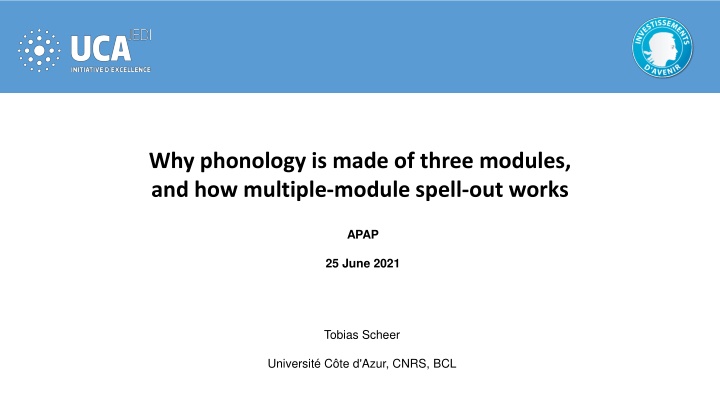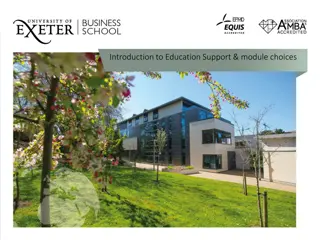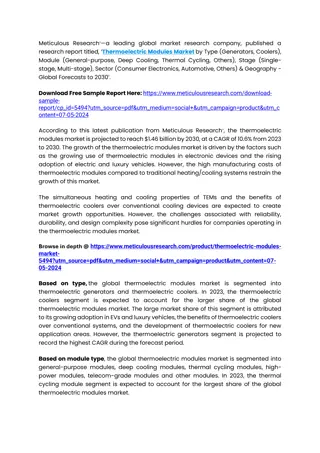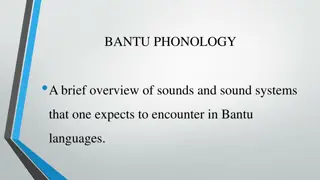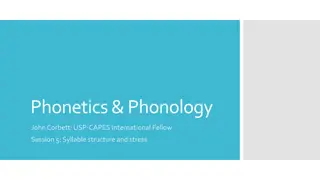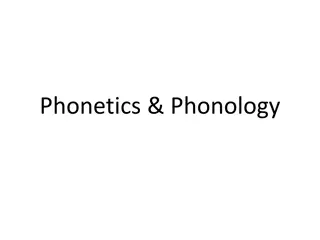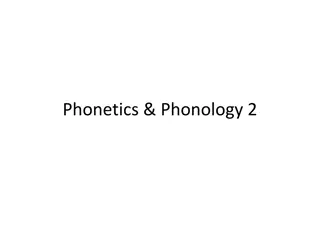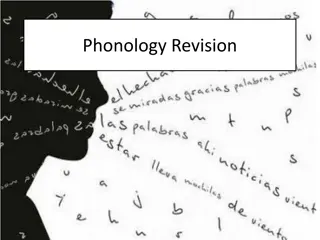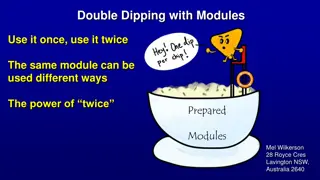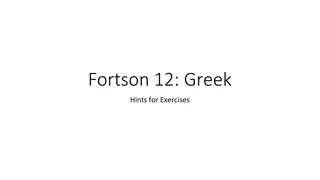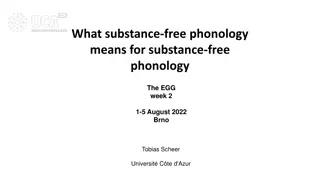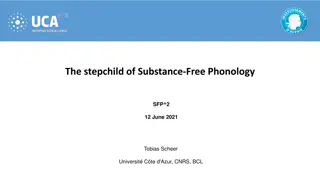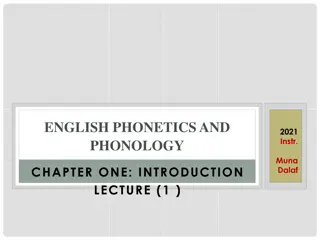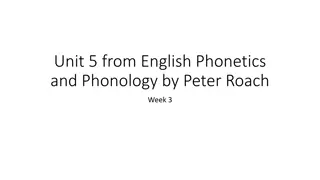The Three Modules of Phonology and Multiple-Module Spell-Out Systems
Phonology is structured into three modules - Sonority, Laryngeal, and Place - each with its own vocabulary and skeleton for computation. These modules interact in multiple-module spell-out systems to map linguistic structures onto phonetic realizations. Sonority, involving the audibility of linguistic messages, differs from Place and Laryngeal properties which convey the linguistic message itself. Structuralization of sonority is a complex topic explored by researchers like Tobias Scheer and Jennifer L. Smith, shedding light on the organization of speech sounds within phonology.
Download Presentation

Please find below an Image/Link to download the presentation.
The content on the website is provided AS IS for your information and personal use only. It may not be sold, licensed, or shared on other websites without obtaining consent from the author.If you encounter any issues during the download, it is possible that the publisher has removed the file from their server.
You are allowed to download the files provided on this website for personal or commercial use, subject to the condition that they are used lawfully. All files are the property of their respective owners.
The content on the website is provided AS IS for your information and personal use only. It may not be sold, licensed, or shared on other websites without obtaining consent from the author.
E N D
Presentation Transcript
Why phonology is made of three modules, and how multiple-module spell-out works APAP 25 June 2021 Tobias Scheer Universit C te d'Azur, CNRS, BCL
each module modular view of phonology has its own vocabulary corresponding to its domain three modules and a skeleton Phonology carries out computation based on this vocabulary, returning structure. Sonority Module a | C b | V c | C skeleton e.g. Son primes StructSon = syllable structure (specified for C and V) Laryngeal Module multi-module spell-out three modules need to be mapped onto phonetics spell-out Place Module at the same time: not trivial solution: what is spelt out is the skeleton, not modules. x ERB y ERB z ERB ERB = Equivalent Rectangular Bandwidth Language-specific phonetics (LSP)
sonority is different Harris, John 2006. The phonology of being understood: further arguments against sonority. Lingua 116: 1483-1494. To be heard vs. to be understood "speech is a modulated carrier signal: the modulations bear the linguistic message, while the carrier enables the message to be heard." the carrier signal, sonority, "is concerned primarily with the audibility of the linguistic message rather than with the message itself" Sonority (Son) = being heard Place of articulation (Place) and laryngeal properties (Lar) = being understood ==> Place and Lar carry the linguistic message that sonority is not conveying
Scheer, Tobias 2019. Sonority is different. Studies in Polish Linguistics 14 (special volume 1): 127-151. 1.1. Structuralization of sonority
structuralization of sonority Smith, Jennifer L. & Elliott Moreton 2012. Sonority variation in Stochastic Optimality Theory: Implications for markedness hierarchies. The Sonority Controversy, edited by Steve Parker, 167-194. Berlin: de Gruyter. Clements, George & Elizabeth Hume 1995. The Internal Organization of Speech Sounds. The Handbook of Phonological Theory, edited by John Goldsmith, 245-306. Oxford: Blackwell. indistinction Son, Place and Lar SPE: features are scrambled in the same unstructured feature matrix OT: constraints are scrambled in the same constraint hierarchy structuralization Feature Geometry Son ([ son], [ approximant], [ vocoid]) features are borne directly by the root node Place and Lar are separated under distinct class nodes.
structuralization of sonority Harris, John 1990. Segmental complexity and phonological government. Phonology 7: 255 300. Standard Government Phonology gives up on representing sonority with specific primes Son is complexity: the more primes involved, the less sonorous is a segment principled divorce between Place & Lar (defined by primes) and Son (defined as a function thereof): the only identity of sonority is structural. complexity faces a number of issues (e.g. i, a, u should be equally sonorous)
Pchtrager, Markus 2006. The structure of length. Ph.D dissertation, University of Vienna. WEB. P chtrager, Markus Alexander & Jonathan Kaye 2013. GP2.0. SOAS Working Papers in Linguistics and Phonetics 16: 51- 64. structuralization of sonority GP 2.0 same idea (the less sonorous the more structure), but structure now embodies as projections in a hierarchy-expressing tree
Schwartz, Geoff 2013. A representational parameter for onsetless syllables. Journal of Linguistics 49: 613-646. Schwartz, Geoff 2017. Formalizing modulation and the emergence of phonological heads. Glossa 2, article 81. structuralization of sonority Onset Prominence takes the arboreal complexity idea to its logical end: all sonorants are treated on a par in a poorly layered structure (Place & Lar primes sit in the Vocalic Onset node)
Carvalho, Joaquim Brando de 2017. Deriving sonority from the structure, not the other way round: A Strict CV approach to consonant clusters. The Linguistic Review 34: 589-614. structuralization of sonority Carvalho's contour-based model different partition: Place (primes) vs. Son & Lar (structure) based on two parallel strict CV tiers, one encoding consonanthood (C-plane), the other representing vowelhood (V-plane) both are synchronized through a central skeleton of timing units
Hulst, Harry van der 1999. Features, segments and syllables in Radical CV Phonology. Phonologica 1996, edited by John Rennison & Klaus K hnhammer. The Hague: Holland Academic Graphics. structuralization of sonority Radical CV Phonology (Dependency Phonology) two basic building blocks (primes), C and V C and V combine along the Dependency principle that one will dominate (head) the other (dependent): CV (C over V, the former being the head) or VC (V being the head). the set {C, CV, VC, V} occurs under the Manner node as much as under the Place node. thus there are no specific primes for sonority. But sonority is not structure alone (as in the other models): it needs primes in order to be expressed, be they multifunctional.
1.2. Diagnostics
Scheer, Tobias 2019. Sonority is different. Studies in Polish Linguistics 14 (special volume 1): 127-151. Diagnostics Selective bottom-up visibility a trivial and undisputed, though rarely explicitly stated fact: Son is projected above the skeleton, but Place and Lar are not. syllable structure is a function of two and only two factors: the linear order of segments and their relative sonority (plus parametric settings). what can be predicted from above C vs. V C1 at least as sonorous as O2 sonority of the tow Cs in O3 what cannot be predicted Place and Lar properties
Scheer, Tobias 2019. Sonority is different. Studies in Polish Linguistics 14 (special volume 1): 127-151. Diagnostics Selective bottom-up visibility syllable structure is built without reference to Place and Lar this indicates that the Son vocabulary on the one hand and Place / Lar vocabulary on the other are distinct: if Place & Lar primes were present and available when structSon is built, they would be expected to be taken into account. the fact that they are not suggests that they occur in a different module. Selective top-down visibility this conclusion is supported by a solid empirical generalization: processes which occur at and above the skeleton may be conditioned by Son, but are blind to Place and Lar.
Yu, Alan C. L. 2007. A Natural History of Infixation. Oxford: OUP. Samuels, Bridget 2009. The structure of phonological theory. Ph.D dissertation, Harvard University. Diagnostics Selective top-down visibility linearization: infixation anchor points that infixes look at in order to determine their landing site are edge-or prominence-oriented. for the left edge for example, documented situations are "after the first consonant (or consonant cluster)", "after the first vowel", "after the first syllable" and "after the second consonant". Prominence-based attractors are stressed vowels, stressed syllables or stressed feet. in no case are Place or Lar reported to be relevant for the definition of the landing site. cases where infixes are inserted after, say, the first labial or voiceless consonant of the word (and in their absence are prefixed) do not appear to be on record.
Paster, Mary 2006. Phonological conditions on affixation. Ph.D dissertation, University of California at Berkeley. Scheer, Tobias 2016. Melody-free syntax and phonologically conditioned allomorphy. Morphology 26: 341-378. Diagnostics Selective top-down visibility phonologically conditioned allomorphy the selection of allomorphs, i.e. independently stored variants of the same morpheme, may be conditioned by purely morpho-syntactic factors (like in the case of go and went, selected according to tense), phonological properties may also play a role. but only Son can be a conditioning factor, cases where Place & Lar play that role are not on record.
Diagnostics Gordon, Matthew 2006. Syllable Weight. Phonetics, Phonology, Typology. New York: Routledge. de Lacy, Paul 2002. The formal expression of markedness. Ph.D dissertation, University of Massachusetts. Selective top-down visibility stress stress placement may be conditioned by syllable structure, i.e. Son: Weight-by- Position (closed syllables count as heavy). a more fine-grained distinction is also found: sonorant, but not obstruent codas contribute to the weight of their syllable. But there is no case on record where Place or Lar has this effect ("a coda is heavy only if it is labial / voiceless") same for vocalic sonority: in many languages, stress placement is sensitive to the sonority of vowels (low, mid, high), but Place and Lar never play a role
Diagnostics Gordon, Matthew 2006. Syllable Weight. Phonetics, Phonology, Typology. New York: Routledge. Selective top-down visibility tone much the same situation as for stress in many languages, contour tones may only appear on heavy syllables, and what counts as heavy may be determined by the presence or absence of a long vowel and a coda, as well as by coda sonority. Place and Lar are never involved in the definition of what counts as light or heavy, though.
Diagnostics S g ral, Philippe & Tobias Scheer 2008. Positional factors in lenition and fortition. Lenition and Fortition, edited by Joaquim Brand o de Carvalho, Tobias Scheer & Philippe S g ral, 131-172. Berlin: Mouton de Gruyter. WEB. Selective top-down visibility positional strength of post-coda consonants Positional strength, i.e. lenition and fortition, is a function of syllable structure (initial and post-coda position is strong, intervocalic and coda position is weak) except for a cross-linguistic parameter that controls the behaviour of consonants in post-coda position. in this context, consonants may either be strong no matter what, or only after obstruents (while following a weak pattern after sonorants) Place and Lar have no bearing on post-coda strength: there is nothing like "post- coda weak if the coda hosts a labial / voiceless consonant"
1.3. Summary
Summary the visibility-based evidence reviewed documents the exclusive reference to sonority for the processes at hand, with Place and Lar being irrelevant and invisible. it would come as a surprise if sonority and melody were cohabitating in the same space: were they all accessible, there would be no reason why some items should be selectively taken into account, while others are actively ignored. therefore, Place and Lar information must not be accessible when sonority computation is carried out, irrespectively of how sonority is represented (structuralized or in the guise of primes). the empirical situation regarding visibility warrants a segregation of sonority and Place / Laryngeal properties into distinct modules, rather than the structuralization of the former.
Summary approaches that make sonority a structural property thus take a step into the right direction by estranging sonority from Place / Lar. but they leave all players in the same space (module). Consequences if a second step is taken that recognizes the segregation of Son and Place / Lar in distinct computational systems, the structural representation of sonority loses its raison d' tre, which is to enact the difference. ==> if there is a Son module, there is no structuralization of sonority. if sonority is a computational system of its own, there must be Son primes: modular computation is always based on primes.
2.1. Substance-free I: Son primes are not emergent
Hale, Mark & Charles Reiss 2000. Substance Abuse and Dysfunctionalism: Current Trends in Phonology. Linguistic Inquiry 31: 157-169. Scheer, Tobias 2019. Phonetic arbitrariness: a cartography. Phonological Studies 22: 105- 118. substance-free phonology (SFP) - intro phonetic information is absent from phonology primes exist to express contrast express phonologically relevant classes (aka natural classes) primes are , , ,
SFP I - innateness Volenec, Veno & Charles Reiss 2018. Cognitive Phonetics: The Transduction of Distinctive Features at the Phonology Phonetics Interface. Biolinguistics 11: 251-294. Odden, David forth. Radical Substance Free Phonology and Feature Learning. To appear in the Canadian Journal of Linguistics. primes have phonetic correlates that come in upon spell- out in the adult they are hard-wired: a spell-out lexicon [x], [y], etc. in the infant they are given = innate (Concordia: Hale, Reiss, Kissock, Volenec) emergent = abstracted from the environment (everybody else: Odden, Dresher, Samuels, Vaux, ) phonology mapping phonetics [x] [y] [z] items innate? yes no associations innate? yes no Concordia everybody else
SFP I - innateness Odden, David forth. Radical Substance Free Phonology and Feature Learning. To appear in the Canadian Journal of Linguistics. Samuels, Bridget, Samuel Andersson, Ollie Sayeed & Bert Vaux forth. Getting ready for primetime: paths to acquiring substance-free phonology. Canadian Journal of Linguistics. there are good arguments for the emergentist position. but nobody ever talks about the area at and above the skeleton = Son Scheer, Tobias forth. 3xPhonology. To appear in the Canadian Journal of Linguistics. because substance is only below the skeleton: you need to get rid of ugly substance-laden [labial], but not of Onset, Ictus, feet, Prosodic Words etc. - thes are already substance-free in otherwise substance- laden approaches.
Clements, George 2009. Does sonority have a phonetic basis? Contemporary views on architecture and representations in phonological theory, edited by Eric Raimy & Charles Cairns, 165-175. Cambridge, Mass.: MIT Press. SFP I - innateness an issue never brought up because it seems trivial: how does the child know that vowels go into nuclei, and consonants into onsets/codas? why are there no flip-flop systems where phonetic vowels are in onsets/codas and phonetic consonants in nuclei? Son primes cannot be emergent if primes are emergent, any association between a phonological and a phonetic category is possible: phonetic arbitrariness [x] if spell-out relations of Son are arbitrary, phonetic vowels could be associated to phonological consonants and thus be syllabified as onsets/codas phonetic consonants could be associated to phonological vowels and thus be syllabififed as nuclei
SFP I - innateness Berent, Iris 2013. The Phonological Mind. Cambridge: CUP. Berent, Iris, Tracy Lennertz, Jongho Jun, Miguel A. Moreno & Paul Smolensky 2008. Language universals in human brains. Proceedings of the National Academy of Sciences of the United States of America 105: 5321 5325. phonology mapping phonetics [x] [y] [z] items innate? yes no associations innate? yes no Son Place, Lar the work by Iris Berent supports the universal and innate character of sonority sonority sequencing is a grammatical universal since it cannot be derived from extra-grammatical factors (such as phonetics) it is active in structures that are unattested in the speaker's language, such as branching onset preferences produced by Korean speakers, whose language lacks branching onsets
2.2. Substance-free II: Son primes are not interchangeable
SFP II - Son primes Scheer, Tobias forth. 3xPhonology. To appear in the Canadian Journal of Linguistics. Place and Lar primes are arbitrary = interchangeable [labial] is just as good as [labial] and are arbitrary and interchangeable symbols they are phonologically meaningless Son primes and the structure they build are not arbitrary = interchangeable items above the skeleton belong to a closed class in all languages: onset, nucleus, ictus, grid mark, foot, prosodic word, etc. they are not interchangeable: you can't replace an onset by a nucleus they are phonlogically meaningful
2.3. Substance-free III: Son computation is not arbitrary
SFP III - Son computation since Place & Lar primes are arbitrary and interchangeable, their computation is arbitrary. Hale, Mark & Charles Reiss 2008. The Phonological Enterprise. Oxford: OUP. any segment can be turned into any other segment in any context and its reverse. ==> phonology is not natural (phonetic naturalness cannot even be calculated since there is nothing phonetic in phonology in the first place) Chabot, Alex 2019. What's wrong with being a rhotic? Glossa 4: article 38. support: crazy rules = that make no sense phonetically speaking Bach, Emmon & R. T. Harms 1972. How do languages get crazy rules? Linguistic change and generative theory, edited by Robert Stockwell & Ronald Macaulay, 1-21. Bloomington: Indiana University Press. l / V__V Sardinian
SFP III - Son computation Scheer, Tobias 2015. How diachronic is synchronic grammar? Crazy rules, regularity and naturalness. The Oxford Handbook of Historical Phonology, edited by Patrick Honeybone & Joseph C. Salmons, 313-336. Oxford: OUP. Chabot, Alex to appear. Possible and impossible languages: crazy rules. Ph.D dissertation, Universit C te d'Azur. crazy rules are only ever segmentally crazy computation concerning items above the skeleton is never crazy there is no compensatory shortening there is no tonic shortening there is no closed syllable lengthening there is no anti-Latin stress (stress the antipenultimate except if the penultimate is short, in which case stress the penultimate)
2.4. Summary
summary Son is different computation is not arbitrary: no crazy Son rules items are not arbitrary: not interchangeable mapping is not arbitrary: phonetic vowels are always in nuclei
3. What kind of animal is sonority?
what kind of animal is Son? if sonority is the same in all languages hard-wired = innate it must have a phonetic correlate children must be equipped at birth to detect this correlate
what kind of animal is Son? Fletcher (1972 [1929]: 82ff) Heffner (1950: 74) Bloch & Trager (1942: 22) Price (1980) Ohala (1992) Wright (2004: 39f) Harris (2006) Clements (2009) Parker (2008, 2011) Gordon et al. (2012) Bakst & Katz (2014) what is this phonetic correlate? perceptual salience, owing to phonetic properties such as loudness, energy and intensity sonority = perceptual salience predates language in humans other species have it it was inherited by the human species Place & Lar are not inherited, they are human innovations.
Ohala, John 1992. Alternatives to the sonority hierarchy for explaining segmental sequential constraints. Papers from the Parasession on the Syllable, Chicago Linguistic Society, 319- 338. Chicago: Chicago Linguistic Society. Harris, John 2006. The phonology of being understood: further argments against sonority. Lingua 116: 1483-1494. what kind of animal is Son? Son is composite: loudness, energy and intensity "sonority does not map to any unitary physical property but is rather a cover term for a collection of independent acoustic properties that contribute to an overall dimension of perceptibility or auditory- perceptual salience." Harris (2006: 1486), also Ohala (1992: 325) entropy counts modulations (modifications of the signal) count, rather than static values. Harris (2006), Ohala (1992: 325)
Stilp, Christian E. & Keith R. Kluender 2010. Cochlea-scaled entropy, not consonants, vowels, or time, best predicts speech intelligibility. PNAS 107: 12387-12392. what kind of animal is Son? universal sonority as "natural consequences of operating characteristics of the mammalian auditory system" entropy Shannon's (1948) information theory the degree of informativeness of an event depends on its entropy, i.e. the uncertainty or unpredictability associated with it the more unexpected, the more informative.
what kind of animal is Son? Stilp, Christian E. & Keith R. Kluender 2010. Cochlea-scaled entropy, not consonants, vowels, or time, best predicts speech intelligibility. PNAS 107: 12387-12392. Cochlea-scaled Spectral Entropy (CSE) "a measure of the relative (un)predictability of signals that is operationalized as the extent to which successive spectral slices differ (or cannot be predicted) from preceding spectral slices. Most simply, CSE is quantified as Euclidean distances between equivalent-rectangular-bandwidth-scaled spectra of fixed-duration (16 ms) sentence slices that were processed by auditory filters" (p. 12388) "[t]his pattern of CSE decreasing from low vowels, to high vowels, to laterals/glides and nasals, to fricatives, to affricates, and finally stops closely parallels the sonority hierarchy" (p. 12389) purely acoustic: "there are no assumptions that the signal is created by a vocal tract" no introduction of constructs such as distinctive features or any property of linguistic theory
Place & Lar are waterproof Scheer, Tobias forth. 3xPhonology. To appear in the Canadian Journal of Linguistics. major generalizations that nobody ever talks about (because they are so trivial?) Place and Lar computation appear to be mutually waterproof Place can impact Place (e.g. velar palatalization) Lar bears on Lar (e.g. voicing assimilation) Place modifications triggered by Lar: a velar is turned into a palatal before a voiceless consonant Lar modifications triggered by Place: a voiceless consonant becomes voiced when followed by a labial outlandish and probably absent from the record
Son impacts Place & Lar Scheer, Tobias forth. 3xPhonology. To appear in the Canadian Journal of Linguistics. recall that there is no bottom-up conditioning: Son (at and above the skeleton) is not influenced by Place or Lar (which live below the skeleton). top-down conditioning (where syllable structure or stress condition Place and Lar) exists, though. Son bears on Lar devoicing (or more generally delaryngealization) in coda position. lenition: typical syllable-conditioned trajectories along the sonority scale involve laryngeal stages, e.g. ph > p > b > v in intervocalic position. Son bears on Place lenition: debuccalization f > h, s > h in coda position. unstressed vowels centralize (become schwa).
Son impacts Place & Lar this should not exist if Son and Place / Lar are located in different modules. but, encouraging: regular Place and regular Lar computation appears to be unimpacted by Son there is nothing like "velars palatalize before front vowels, but only if they belong to a coda" or "obstruents undergo progressive voice assimilation, but only if they are engaged in a branching onset". this suggests that Place- and Lar-internal computation is indeed insensitive to Son, as predicted.
Son impacts Place & Lar focus on the prototypical case: lenition and fortition inoffensive cases: Son-internal computation (stop --> fricative / V__V) offensive: debuccalization involves the loss of Place primes and may thus not be described as a rearrangement of Son primes. positions are weak or strong, not segments segmental effects are due to positional strength / weakness thus the impact of Son on Place & Lar is indirect, not direct Son defines the strength of skeletal positions, which are then read off by Place and Lar
Son impacts Place & Lar this mechanism may be generalized structSon bears on timing units and makes them more or less apt at sustaining (licensing) primes that are associated to them. a strong position is a position that allows for a large number of primes to be associated, while a weak position can only sustain a few, or indeed no prime. timing units do not belong to any particular module but rather instantiate the temporal and linear sequence. the primes of all three modules that co-define a segment are attached to the timing unit that defines this segment Son defines the strength of skeletal positions, which are then read off by Place and Lar
Son impacts Place & Lar three modules and a skeleton each module has its own vocabulary corresponding to its domain Sonority Module a | C b | V c | C carries out computation based on this vocabulary skeleton (specified for C and V may be impacted by the status of the skeletal slot it is attached to (strong, weak) Laryngeal Module this status is defined by Son. Place Module
